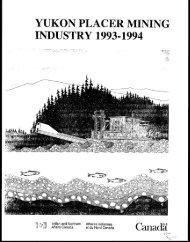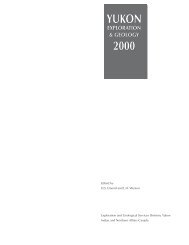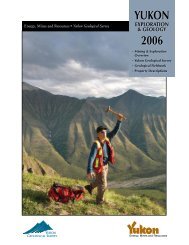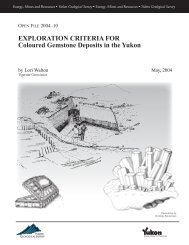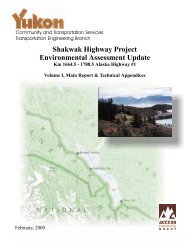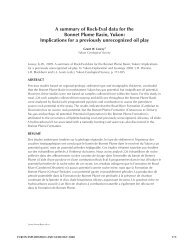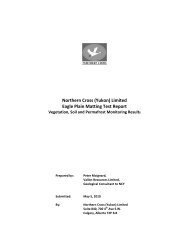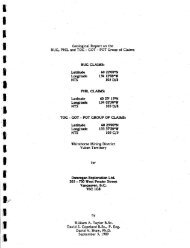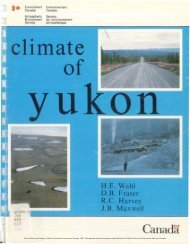JohnS. Vincent, P.s«g.
JohnS. Vincent, P.s«g.
JohnS. Vincent, P.s«g.
Create successful ePaper yourself
Turn your PDF publications into a flip-book with our unique Google optimized e-Paper software.
I<br />
I<br />
I<br />
87-013<br />
Vol. 1<br />
Vancouver, B.C.<br />
A SUMMARY REPORT<br />
on the<br />
BARNY PLATINUM - NICKEL PROSPECT<br />
Yukon Territory<br />
for<br />
Rockridge Mining Corporation<br />
and<br />
Pak-Man Resources Inc.<br />
by<br />
John S. <strong>Vincent</strong>, P.Eng.,<br />
Consulting Geologist<br />
L <strong>JohnS</strong>. <strong>Vincent</strong>, P.<strong>s«g</strong>.<br />
March 6, 1987,
I<br />
SUMMARY AND CONCLUSIONS<br />
INTRODUCTION<br />
PROPERTY, LOCATION AND ACCESS<br />
HISTORY AND WORK TO DATE<br />
GEOLOGY<br />
Regional Setting<br />
Barny Property<br />
Mineralization<br />
Trenching<br />
Sampling & Analytical Work<br />
RECOMMENDATIONS<br />
COST ESTIMATE<br />
REFERENCES<br />
CERTIFICATE<br />
TABLE OF CONTENTS<br />
APPENDIX<br />
Staking verification letter<br />
ILLUSTRATIONS<br />
Location Map<br />
Claim Map<br />
Wellgreen Belt Structural Blocks<br />
Wellgreen Belt<br />
Property Geology: West, Centre, East, A, B, C,<br />
Magnetometer Survey: A, B, C,<br />
^ohnS. <strong>Vincent</strong>, p.s^.<br />
Page 1.<br />
1.<br />
3.<br />
4.<br />
4.<br />
6.<br />
8.<br />
9.<br />
11.<br />
11.<br />
12.<br />
15.<br />
Figure 1.<br />
2.<br />
3.<br />
4.<br />
5. 6.<br />
16.
I<br />
i<br />
I<br />
''^ r Sil,: - .y''i '"La^vf^s<br />
(>. '^<br />
c<br />
Prince George<br />
^pN^ y-i^ J ^%^^ ^f \I<br />
J'w»/«*,a«<br />
S"'» = l".40m.l«<br />
1: 2,900.000<br />
Rockridge Mining Corporation<br />
ana<br />
Pak-Man Resources Inc.<br />
BARNY PROPERTY<br />
LOCATION MAP<br />
Oat*:<br />
Februory 1987<br />
JOHN S. VINCENT LTD.<br />
SBTS<br />
115-6/5,6<br />
FiQur*
i<br />
I L<br />
-1-<br />
INTRODUCTION<br />
At the request of Mr. Ralph R. Brown, President of Rockridge<br />
Mining Corporation, and Mr. F. Marshall Smith, P.Eng., a Director<br />
of Pak-Man Resources Inc.,the writer has prepared a summary<br />
report on the Barny Platlnum-Nlckel Prospect which is located two<br />
miles northwest of the Wellgreen Mine. The study is based on a<br />
review of the compilation and field work carried out by the<br />
Kluane Joint Venture over the 1986 field season, and from data<br />
compiled in the area by the writer over the period 1970 - 1972.<br />
At that time the Wellgreen Mine was studied in detail and<br />
exploration was carried out over the claim blocks adjoining to<br />
the northwest and southeast. This work was carried out by the<br />
Nickel Syndicate under the writer's supervision.<br />
The various claim holdings along the 10 mile belt were assembled<br />
by the Kluane Joint Venture over the 1986 season, and the BARNY<br />
group has been optioned to Rockridge Mining Corporation and Pak-<br />
Man Resources Inc. The Kluane Joint Venture consists of Chevron<br />
Minerals Ltd., 50*, and All-North Resources Ltd.,509;, and the<br />
latter is currently acting as the Operator.<br />
The body of this report consists of a review of past work, a<br />
description of the claims, a description of the geology and<br />
distribution of metal values, and recommendations for the<br />
continued evaluation and exploration of the property.<br />
PROPERTY, LOCATION & ACCESS<br />
The Barny Prospect is located in the western Yukon Territory<br />
approximately 200 miles northwest of Whitehorse, and immediately<br />
west of Mile 1111 on the Alaska Highway; Figure 1. Road access<br />
is available from Mile 10 on the Wellgreen Mine road, which<br />
leaves the Alaska Highway at Mile 1111. At this point a rough<br />
two wheel drive road leads on into the Arch Creek valley and the<br />
old Nickel<br />
3ohnS. <strong>Vincent</strong>, p.sng. )
i.B KllomalfM<br />
Rockridge Mining Corporation<br />
and<br />
Pak-Man Resources inc.<br />
BARNY PROPERTY<br />
Seol«: |"(|/emll*<br />
1:30.000 ggprw.<br />
CLAIM MAP<br />
Oalct<br />
Februory 1987<br />
JOHN S. VINCENT LTD.<br />
Iffs.<br />
ns-G/s<br />
?i«u
-2-<br />
Syndicate camp.<br />
Arch Creek flows northwesterly into the Donjek River, and<br />
abundant streams drain into Arch Creek from the adjacent slopes.<br />
The upper Arch valley is V-shaped with a relatively steep and<br />
narrow profile. Evergreens grow more abundantly on the northern<br />
side of the valley to an average elevation of 4600 feet. Buck<br />
brush tends to create trying conditions, but above- the 5500 foot<br />
elevation slopes are grassed and relatively barren.<br />
The claims are plotted on Sheet 115 G-5 & 12, and held by Archer,<br />
Cathro and Associates (1981) Limited on behalf of the Kluane<br />
Joint Venture.<br />
Rockridge and Pak-Man Resources Inc. have acquired the property<br />
from the Joint Venture under the terms of an Option Agreement.<br />
The following tabulation is reproduced from Schedule "A" as<br />
attached to the Agreement dated December 12th, 1986.<br />
Claim Name<br />
Barny<br />
Barny<br />
Barny<br />
Barny<br />
Barny<br />
Barny<br />
Barny<br />
Barny<br />
Barny<br />
Barny<br />
Barny<br />
Barny<br />
Barny<br />
Barny<br />
Mus 1<br />
MiiR 2<br />
Mils 3<br />
Mus 4<br />
Mus 5<br />
Mus 6<br />
Mus 7<br />
Mus 8<br />
1<br />
2<br />
3.<br />
4<br />
5<br />
6<br />
7<br />
8<br />
9<br />
10<br />
11<br />
12<br />
13<br />
14<br />
Grant No.<br />
YA<br />
YA<br />
YA<br />
YA<br />
YA<br />
YA<br />
YA<br />
YA<br />
YA<br />
YA<br />
YA<br />
YA<br />
YA<br />
YA<br />
YA<br />
YA<br />
YA<br />
YA<br />
YA<br />
YA<br />
YA<br />
YA<br />
94968<br />
94969<br />
94970<br />
94971<br />
94972<br />
94973<br />
96002<br />
96003<br />
96004<br />
96005<br />
96006<br />
96007<br />
96008<br />
96009<br />
94962<br />
94963<br />
94964<br />
94965<br />
94966<br />
94967<br />
96010<br />
96011<br />
I John S. <strong>Vincent</strong>, P.S^V.<br />
Expirv Date<br />
June 12, 1987<br />
n<br />
n<br />
n<br />
n<br />
n<br />
Aug. 22, 1987<br />
n<br />
n<br />
n<br />
II<br />
June<br />
Aug.<br />
n<br />
n<br />
II<br />
12, 1987<br />
If<br />
II<br />
II<br />
If<br />
It<br />
27, 1987<br />
n
Mus<br />
Mus<br />
Mus<br />
Mus<br />
Mus<br />
Mus<br />
Mus<br />
Mus<br />
Amp<br />
Amp<br />
Amp<br />
Amp<br />
Amp<br />
Amp<br />
Amp<br />
Amp<br />
Amp<br />
Amp<br />
9<br />
10<br />
11<br />
12<br />
13<br />
14<br />
15<br />
16<br />
1<br />
2<br />
3<br />
4<br />
5<br />
6<br />
7<br />
8<br />
9<br />
10<br />
-3-<br />
YA 96012 Aug. 27, 1987<br />
YA 96013 "<br />
YA 96014 "<br />
YA 96015 "<br />
YA 96016 "<br />
YA 96017 "<br />
YA 96018 "<br />
YA 96019 "<br />
YA 95100 July 11, 1987<br />
YA 95101<br />
YA 95102 "<br />
YA 95103 "<br />
YA 95104 "<br />
YA 95105 "<br />
YA 95106 "<br />
YA 95107<br />
YA 95108<br />
YA 95109<br />
The Barny and Mus claims were staked by Archer Cathro and the Amp<br />
claims were acquired by option from Mr. Graham Davidson through<br />
an agreement dated December 4th, 1986.<br />
Although the writer has not had an opportunity to examine the<br />
claim posts, the work of Archer, Cathro and Associates is well<br />
regarded, and there is no hesitation in accepting.their results.<br />
HISTORY & PREVIOUS WORK<br />
The current Barny group of claims covers several sulphide<br />
showings which have been staked intermittently since 1952, when<br />
the adjacent Wellgreen-Quill Creek discovery was being explored.<br />
The Nickel Syndicate explored the area under the supervision of<br />
the writer over the period 1971-1972. During this time the<br />
results of earlier efforts were compiled and utilized as<br />
effectively as possible. Several magetometer surveys had been<br />
carried out over the years using a variety of instrumentation.<br />
The Syndicate confirmed these results with an up-dated detailed<br />
survey; Figure 6, A,B,& C. Mr. R. Hilker, P.Eng. had carried out<br />
^ohnS. <strong>Vincent</strong>, P. eng.<br />
n<br />
n<br />
n
-4-<br />
mag and VLF-electromagnetic surveys in 1967, and the trace of<br />
these condictors is also shown on Figure 6. The Nickel Syndicate<br />
program included detailed geological mapping, sampling,<br />
magnetometer surveying, and bulldozer trenching.<br />
Regional Setting;<br />
GEOLOGY<br />
The Wellgreen Belt, which includes the BARNY Prospect, is<br />
located 4 miles south of the Shakwak Trench which separates the<br />
rugged St. Elias Mountains to the southwest from the Yukon<br />
Plateau to the northeast. The Trench is a major crustal break<br />
which trends northwesterly through the western Yukon.<br />
The rocks of the St. Elias consist of an older core of<br />
metamorphic and granitic material and a folded and faulted<br />
sequence of mid-Paleozoic to lower Cretaceous volcanics and<br />
sediments. These sequences were intruded during the Triassic by<br />
Komatiitic ultramafic complexes of peridotite, gabbro, and<br />
dunite. In G.S.C. Memoir 340 Dr. Muller groups the sedimentary<br />
and volcanic rock types, and distinguishes three main volcanic<br />
packages: the Dezadeash being the oldest, the Cache Creek, and<br />
the Mush Lake as the youngest.<br />
The structural fabric of lithology, thrust faults, and the traces<br />
of fold axis trend northwesterly at 110*-130*. Northerlydraining<br />
creeks reflect cross-cutting lineaments which dissect<br />
the Kluane Ranges along the northeast flank of the St. Elias .<br />
Movmtains. Folding and faulting can be observed on a variety of<br />
scales. Figure 3 is a schematic sketch of the Wellgreen Belt<br />
which illustrates the relationship between the fault and fracture<br />
systems, and the broad distribution of ultramafic bodies between<br />
Arch Creek on the northwest, through the Wellgreen Mine area, to<br />
SohnS. <strong>Vincent</strong>, psng.
-5-<br />
Linda Creek to the southeast. The latter block may be displaced<br />
a few hundred feet to the northeast relative to the Wellgreen<br />
block.'<br />
Nickel - copper occurrences are spread along a strike length of<br />
100 miles through the Kluane District southwest of the Shakwak<br />
Trench. The Dickson Creek prospect in the southeast, the<br />
Wellgreen Mine in the center, and the Canalask property in the<br />
far northwest of the Kluane map sheet are of economic<br />
significance. These deposits are found in a similar geologic<br />
setting in association with peridotites, gabbros and strongly<br />
fractured and sheared sedimentary wall rock.<br />
Within the area cover by Figure 3 several significant sulphide<br />
prospects occur along a 3 mile strike length. The Wellgreen Mine<br />
in the center is a former producer which shipped nickel-copper<br />
concentrates to Japan during 1972 and 1973. At the time of<br />
closure in 1973 the proven ore reserve hosted by heavy sulphide<br />
mineralization was calculated at 626,430 tons grading 2.04%<br />
nickel, 1.45% copper, 0.065% cobalt, and 0.030 ounces of platinum<br />
and 0.024 ounces of palladitim per ton. Surface sampling in 1986<br />
by the Kluane Joint Venture returned values ranging up to 0.193<br />
ounces of platiniim and 0.210 ounces of palladium per ton from<br />
stockwork sulphide stringers in a gabbroic host rock within the<br />
mine area. The other platinum group elements (PGE) are also<br />
present in very significant amounts. Recent work by the GSC which<br />
confirms the Komatiite relationship and relative high PGE values<br />
is of particular significance because of the demonstrated<br />
favourable economic potential. Typical occurrences which are<br />
well documented in the literature are the Kambalda deposits in<br />
Western Australia and the Langmuir deposit near Timmins, Ontario.<br />
(Cabri,1981} The Kambalda area was initially of interest for its<br />
gold deposits, and the sulphides have an average gold content of<br />
400<br />
3ohnS. <strong>Vincent</strong>, psng.
-6-<br />
ppb in comparison to
"''<br />
LIMESTONE<br />
0UART2ITB<br />
Oulcrep boundary<br />
y-f Tolui, poorly dtfinod<br />
oulcrep feoundory<br />
jfTi^ Mat Iraeod Porldolito<br />
*'
B INTERMED.<br />
0<br />
T<br />
.'::^i--'<br />
PERIDOTITE<br />
VOLCANICS<br />
ACIDIC<br />
VOLCANICS<br />
fTTI SHALE,SLATE,<br />
I" I PHYLLITE<br />
[u] LIMESTONE<br />
[is] QUARTZITE<br />
*\** :'''x'',
-7-<br />
The ultramafic complex exposed on the Barny claims is<br />
represented by serpentinized peridotite and gabbro. The bodies<br />
are roughly conformable with the enclosing stratigraphy, and work<br />
along the Kluane Belt over the years has shown the complex to be<br />
generally sill-like.<br />
The peridotite is usually serpentinized, dark greenish-black and<br />
medium grained. It weathers dark green with brown limonite spots<br />
and frequent white to greenish white coatings of calcite.<br />
31ickensided scaly fractures are common and dominate weathered<br />
material. The peridotite is strongly magnetic.<br />
In thin section the rock consists of rounded masses and belted<br />
aggregates of relict olivine. Approximately 10^ of the rock is<br />
made up of interstitial orthopyroxene (Sinclair, 1971).<br />
Figure 5 illustrates the outline of areas underlain be peridotite<br />
and gabbro as mapped by the Nickel Syndicate. Figure 6 shows the<br />
magnetic signature of these rocks and demonstrates the good<br />
correlation of the response with geology. The ultramafic unit is<br />
split between the two bodies outlined along the total strike<br />
length of 15,000 feet. The main sulphide showing is located in<br />
the central portion of the eastern body. This segment is 5,000<br />
feet long and up to 900 feet wide. The western body has a<br />
similar sinuous outline and extends for 7000 along strike<br />
The crabbros resemble the varieties found at the Wellgreen. The<br />
rock is composed mainly of chloritized pyroxenes and altered<br />
plagioclase laths with occasional small patches of serpentine.<br />
At chilled margins the fine grained phases are easily confused<br />
with volcanic rocks. A mix of intrusive features between the<br />
peridotite and gabbro suggests a degree of contemporaniety.<br />
Extensive studies by others in areas of ultrmafic complexes have<br />
led to the<br />
{fohn S. <strong>Vincent</strong>, peng.
^<br />
•f 1000 If Centoure Mre<br />
traced by pace ond cempaci<br />
Contour inlerval • IOO 0anwMe<br />
0 am 400 eoo 600 looo r^et<br />
800 Melrec<br />
Rockridge Mining Corporation<br />
and<br />
Pak-Man Resources inc.<br />
BARNY PROPERTY<br />
MAGNETOMETER SURVEY<br />
Scale: I'eSTO'<br />
I I 8000<br />
West<br />
Dele:<br />
February 1987<br />
JOHN S. VINCENT LTD.<br />
NTS<br />
119-6/9,6
I Rockridge Mining Corporation<br />
and<br />
Pak-Mon Resources Inc.<br />
BARNY PROPERTY<br />
MAGNETOMETER SURVEY<br />
Scale: {"tSTO*<br />
(•6000<br />
Dale:<br />
Februory 1987<br />
JOHN S. VINCENT LTD.<br />
NTS<br />
li 9-6/9,6<br />
Figure.<br />
6c
I<br />
-8-<br />
conclusion that they were emplaced together as crystal mushes.<br />
Thus, mutually intrusive and gradational relationships can be<br />
observed. Magmatic differentiation is evident in the sequence of<br />
events, and the sulphide components would also be part of the<br />
later phases of the process. Interstitial mineralization can be<br />
expected, as well as sulphide deposition along faults and<br />
fractures. It is also likely that different ages of sulphides<br />
will be available from the melt, probably with varying metal<br />
contents.<br />
Observations made by the writer at the Wellgreen Mine support<br />
these thoughts, and also confirm an intimate association of<br />
interstitial nickeliferous sulphides with the gabbroic phase of<br />
the complex. Thus, it is evident that these rocks are an<br />
economically important portion of the mafic-ultrmafic complex.<br />
Mineralization:<br />
The two main types of mineralization mapped by the Nickel<br />
Syndicate were the disseminated sulphides in gabbro, and massive<br />
stringers and zones localized by fractures in close proximity to<br />
the peridotite and gabbro. Table 1 compiles the sample results<br />
and descriptions of a number of sulphide occurrences mapped. The<br />
grid references tie into Figures 5 and 6 which illustrates the<br />
Syndicate survey grid. These picket lines can likely be found<br />
and the re-located grid used for the continuing work.<br />
In a report to the Nickel Syndicate dated October 5, 1971, the<br />
writer recorded personal sample results along with those reported<br />
by previous examiners. The main exposure along upper Arch Creek<br />
which was sampled by the writer consisted of a 3 foot wide zone<br />
of massive sulphide along the contact between serpentinite and<br />
tuffs. A hand trench had opened up the showing for 15 feet along<br />
strike. The following assay results were obtained.<br />
I<br />
|l ..^^ohnS. <strong>Vincent</strong>, Peng.
i<br />
I<br />
-9-<br />
Sample Copper Nickel<br />
#4327 Tuffs<br />
4328 Massive sulphide, 3 ft<br />
4329 Serpentinite, 10 ft<br />
Sampling by previous examiners v<br />
Hilker, Massive sulphide<br />
52 ft. composite<br />
Gavin, 3.5x38 ft composite<br />
Gibbons, 120 ft. composite<br />
Prospector, Massive sulphide<br />
float<br />
grab sample<br />
0.129S<br />
1.05<br />
0.20<br />
•e reported as<br />
2.565K<br />
0.32<br />
1.79<br />
0.12<br />
2.50<br />
0.83<br />
0.22%<br />
3.00<br />
0.32<br />
follows:<br />
3.78!l!<br />
—<br />
2.03<br />
0.53 •<br />
3.90<br />
0.27<br />
A sample of massive sulphide mineralization from the main showing<br />
collected by F.A. Campbell in 1955, which was assayed for PGE by<br />
Falconbridge, returned values of 0.045 oz/ton platiniim, 0.044<br />
oz/ton palladium and 0.012 oz/ton rhodivim.<br />
The mineralization exposed in Arch Creek is similar in occurrence<br />
to the material on the Wellgreen Property 12,000 feet along<br />
strike to the southeast, and continued work is justified to<br />
evaluate the potential for further mineralization.<br />
Trenching:<br />
A total of 6 trenches were cut in the fall of 1972 located as<br />
shown on Figure 4 a, which moved 13,000 cubic yards of material.<br />
The following Tables 2 through 7 have been extracted from the<br />
Nickel Syndicate report, and present the results of the sampling<br />
carried out in the cuts. Copper and nickel values are reported<br />
in parts per million (ppm), and determinations were made using<br />
aqua-regia and hot ascorbic acid extractions. The latter<br />
extracts only sulphide-hosted nickel, whereas aqua-regia removes<br />
total nickel from both sulphides and silicate minerals.<br />
Trenches 1-4 were cut through the northern side and contact area<br />
of the eastern peridotite body, and the background metal values<br />
are strong through the ultramafic.<br />
^ohnS. <strong>Vincent</strong>, peng.
Ref.#<br />
1<br />
2<br />
3<br />
4<br />
5<br />
1 ^<br />
Location<br />
8E 30N<br />
Host Rock<br />
Gabbro/<br />
Chert<br />
16E 28.5N Gabbro/<br />
Chert<br />
36E ION<br />
4.5E 16N<br />
53.5E 14N<br />
Approx.<br />
65E 15N<br />
Peridotite/<br />
Argillite<br />
Cherts<br />
Large chert<br />
xenolith at<br />
peridotite<br />
contact<br />
Peridotite/<br />
m.volcanic<br />
Structural Control<br />
Fracture filling<br />
at shear contact<br />
Fracture filling<br />
at shear contact<br />
Fracture filling<br />
at shear contact<br />
south of peridotite<br />
body<br />
Fracture filling<br />
+ coating south<br />
of 120" striking,<br />
fault<br />
Fracture filling<br />
at shear contact<br />
Mineralized zone<br />
truncated at east<br />
end<br />
Fracture filling<br />
along shear zone<br />
TABLE OF MINERAL OCCURRENCES<br />
Type<br />
Very fine grained<br />
massive; mainly<br />
iron oxide containing<br />
rare<br />
sulphide specs<br />
Iron sulphide<br />
coarse crystalline<br />
cubic pyrite<br />
accumulations<br />
Cu-Ni sulphide<br />
massive, layered<br />
Cu-Ni sulphide<br />
oxidized<br />
Cu-Ni-Fe sulphide<br />
Massive<br />
Sulphide<br />
Associated<br />
Metallics<br />
Magnetite,<br />
Pyri te<br />
Pyrite<br />
Pyrrhotite,<br />
Chalcopyrite,<br />
Pyri te<br />
Malachite,<br />
little chalco<br />
pyrite, minor<br />
Pyrrhotite<br />
Pyrrhotite,<br />
Marcasite,<br />
Pentlandite,<br />
Chalcopyrite<br />
Pyrrhotite,<br />
Pyrite<br />
Assay Values<br />
Cu Ni<br />
-^O.OIX<br />
550ppm<br />
0.06%<br />
1.74X<br />
0.02%<br />
20ppm<br />
0.26%<br />
0.28%<br />
Massive form<br />
1.055; 3.00%<br />
in peridotite<br />
0.20% 0.32%<br />
in chert<br />
0.12% 0.22%<br />
Not analysed<br />
Remarks<br />
Extent unknown, 30 cm<br />
long slabs recovered<br />
from overgrown rubble<br />
Narrow zones, traced<br />
for 30 feet<br />
Finger thick segmented<br />
tabular bodies in 1 ft<br />
wide shear zone,<br />
traced for 6 ft.<br />
2 patchy Indications<br />
of mineralization,<br />
3 ft. across<br />
Exposure variable up<br />
to 3 ft. wide, 20 ft.<br />
long. Zone is open to<br />
west, cut off by fault<br />
at east end<br />
2 ft. wide mainly<br />
covered mineralized<br />
zone traced for 5 ft.<br />
'
Ref.# Location Host Rock Structural Control Type Associated<br />
Metallics<br />
84E Fine grained Close northerly of Disseminated iron Pyrite<br />
Gabbro fault (110/62S) sulphides. Irreg.<br />
specs, 1 mm across.<br />
Randomly distributed;<br />
1%<br />
8 84E 8.5N Gabbro<br />
84E 17N Gabbro<br />
Same as under #7 Pyrite<br />
Same as under #7 Pyrite<br />
Assay Values<br />
Cu Ni<br />
Remarks<br />
0.01%
•Jiratst "ha?!<br />
V-7L YOt^OL<br />
m-ois 1ft«D')»d<br />
9ise9<br />
L
SUtlOH<br />
koo<br />
VMi<br />
IS<br />
ao<br />
aq*>«<br />
7.<br />
(><br />
2i 9 IZ. I<br />
Awo & 7 10 /<br />
5K» 24 5 7<br />
MCD >& S" 7<br />
7«& IS 4 4.<br />
.c^^*^--<br />
S«cJ«. I"* lOo'<br />
•^ Son^rv<br />
1«2J<br />
•J1Z4<br />
Cu. Nt<br />
9\ 117<br />
ppm<br />
fll ca.<br />
Cu. Nl<br />
51- 50<br />
^ 4A<br />
'8(inan&<br />
M»\0»K.<br />
&M»l$'<br />
mnefc.<br />
InS 111 I7& * a mw.«i**t<br />
n^U. 240 fc^- no IT* ^'^'^<br />
lan 2» I82> i» tee fuJoW<br />
7I2& leo eoD
sortioa M.d»h dafAWi Otfinxi,<br />
Ono zo 4 4<br />
l«0O JS (e U I<br />
2H» 4* 7 6<br />
SafftftuiO Cu. Ml<br />
mo.<br />
HOT nu STD 90 IQS<br />
Tio6 5» iBco WC la<br />
i»oo » 7 t \ / T«*f lo tflS 440 qw<br />
4*00 aa S s<br />
5»a 16 4 4<br />
b^cd S 4- 4^<br />
liio 3s> ««? as 3«<br />
Tin sae 8*0 210 4w<br />
710, «a» -j^ gDO las<br />
Cu. Mi Rairafi^ Va.relC<br />
pri4£*i*t^W ^la'Zt-<br />
f»ruleiH« 427.>l#<br />
pndoKt sa-^i<br />
pr,ddhti .^2.i>4K»<br />
paridrt'ti IS(»-I]<br />
plfidohti 120 •'TO<br />
Secle. I-., loc/ ARCH (afZouP<br />
TOENW Uo^r3<br />
OCT- 2. 72<br />
TWW- ISS4
I<br />
OiflO •6 3 2<br />
WO 5 4 Z<br />
Jroo 14- 5 3<br />
MD »+ e A<br />
4«0 IS -J S<br />
5H0 S & C<br />
&UD<br />
Spilo^<br />
u<br />
-^C£^e r'sioo'<br />
-TV? 4i0 iSD 226 wo fu-4dKb(uWt "664<br />
ni\t> tu* itlS Tib Ti^<br />
liK\ 3BO lUT? lis MJ<br />
liZO 430 ^ fceO ptTidoMi<br />
Qoa<br />
IW72&<br />
TI2I iee> MO MJ 3BS 217.^<br />
7121. W6 g»$ qS730 p,tfl.^t 722 2L<br />
"HZENCH NT 72-4<br />
OCT. Z7572-<br />
Totl -770S6»'C«.,
&attf\ iMi«> ^jcpttn oafKhz,<br />
Oreo IS 4 4-<br />
HDO lb 4 4<br />
2+co 2? 3 S<br />
3*00 2D I<br />
^IS^<br />
'-<br />
L<br />
^c^wlt riiccy<br />
712^<br />
«?l IO<br />
7130 TL 7B<br />
7ia «) Kif;<br />
7152. Tk? 90<br />
Cm, Ml Qunanct yanli<br />
^AO ^(tl flfc.30<br />
epx\/al<br />
cjnjvucl<br />
CfcX 2> iQ71^<br />
I52-7L<br />
©S.|
I<br />
i<br />
I<br />
0»oo H 2. 3<br />
lH» 15 > 4<br />
2*» «v 4 5<br />
3«co S" 4 5<br />
4^ 13 S 4<br />
stco IS" 4 5<br />
t4a> IT 3 4<br />
7W ifl- 3 3<br />
t"* 100'<br />
^«*«. lt«J.IV<br />
janvcteno Cu. Ni<br />
IXVii ^ i»>0<br />
-7cyv '3» "ll-<br />
7i3s los cr?<br />
7i3A^ t\0 II<br />
\>ol(AAi/ I7V1V<br />
IO&{/
I<br />
^<br />
Saroplinq & Analytical Work:<br />
-10-<br />
It is to be expected that the distribution of the platinum group<br />
elements will be heterogeneous both at the scale of the deposit<br />
and within a sample. Within a given deposit there will be<br />
significant variations between rock types, sulphide phases, and<br />
mineralogical differences. At the Wellgreen, for instance,<br />
analytical results from samples collected during the 1986 program<br />
show that apparently weakly mineralized gabbro low in copper and<br />
nickel values has an important PGE content. Thus, visual<br />
evaluation is not sufficient. Within a sample erratic<br />
concentrations can also create spurious analytical results. As<br />
a result, sample size and preparation become very important<br />
considerations in the design of evaluation studies.<br />
Bondar-Clegg and Co. Ltd. has carried out the analytical work for<br />
both the Nickel Syndicate and the Kluane Joint Venture, and their<br />
work is considered very reliable. Their services are widely<br />
accepted by the industry. Following a rigorous checking of<br />
their expertise and techniques. Chevron chose them to do the<br />
analytical work on their Stillwater Platinum project in Montana.<br />
Where all the PGE elements are to assayed for, the initial<br />
element collection phase of the procedure utilizes the nickel<br />
sulphide fusion technique developed in South Africa. With this<br />
method Iridium and Osmixim losses are avoided. If only platinum<br />
and palladixim analysis are required a lead collection method is<br />
used. In either case, neutron activation analysis (NAA) is used<br />
to determine the PGE content.<br />
In stimmarv, work on the area now covered by the Barny claim group<br />
over the period 1953 to 1986 has found nickeliferous sulphide<br />
mineralization similar in composition and host rock to that mined<br />
at the Wellgreen Mine two miles to the southeast. Preliminary<br />
sampling has indicated an appreciable platinum-palladitun content<br />
<strong>JohnS</strong>. <strong>Vincent</strong>, peng.
I<br />
-11-<br />
to the sulphides. The Barny prospect lies within the Wellgreen<br />
Belt which has a very favourable economic potential, and<br />
continued exploration and evaluation is fully justified.<br />
RECOMMENDATIONS<br />
It is recommended that a 2-Phase program be carried out to<br />
evaluate the distribution and economic potential of the platinum<br />
group elements and the hosting nickeliferous sulphides found to<br />
date. Soil sampling, geophysical surveying, trenching, and<br />
diamond drilling will be required. Although soil sampling is<br />
perhaps not generally regarded as effective for platintim,<br />
orientation surveys over the Wellgreen deposit have demonstrated<br />
that it is a useful tool for these local conditions. Soil<br />
profiles over the zones on the' Barny Prospect can be sampled for<br />
orientation, and a proper survey initiated accordingly. The work<br />
should be planned as follows:<br />
Phase 1:<br />
Establish a survey grid, and collect soil samples to be analysed<br />
for copper, nickel, platinum, palladium, cobalt, chromium, gold,<br />
and silver. It may be possible to re-locate the Nickel Syndicate<br />
grid. Preliminary to this, examine and sample the soil profile<br />
at selected spots for orientation purposes. Carry out<br />
gradiometer-magnetic and VLF electromagnetic surveys, and followup<br />
anomalous signatures with induced polarization techniques.<br />
The sensitivity provided by the gradiometer may well delineate<br />
between the gabbro and peridotite host rocks and the varying<br />
sulphide content. Soil sampling has proven effective over the<br />
Wellgreen deposit, and this combination of geophysical methods<br />
has responded favourably in orientation surveys carried out over<br />
Johns. <strong>Vincent</strong>, peng.
-12-<br />
selected areas of known mineralization.<br />
Target areas will then be evaluated by bulldozer trenching and<br />
diamond drilling.<br />
Phase 2;<br />
Contingent on positive results from the initial phase, continued<br />
drilling will be required to assess the areas of mineralization<br />
and favourable geology.<br />
Phase 1;<br />
COST ESTIMATE<br />
Personnel:<br />
Project Geologist: 3 mos @ $5000 $15,000<br />
Geochem Crew: 7,000<br />
Benefits @ 15% 3,300 $25,300<br />
Personnel Costs:<br />
Camp Costs; Est. 250 man days @ $25<br />
Transportation:<br />
a) Travel;<br />
b) 2 1/2 trucks mos @ $1,500<br />
2,000<br />
3,750<br />
$ 6,250<br />
5,750<br />
Grid: Estimate 75 Kn @ $200 15,000<br />
Geophysics:<br />
Estimate<br />
Analytical:<br />
a) Soils: 500 § $15<br />
b) Assay; 600 @ 25<br />
100 @ 75<br />
Bulldozer:<br />
Trenching and drill roads;<br />
Estimate 50 hours @ $120<br />
$ 9,000<br />
15,000<br />
7,500<br />
L Johns. <strong>Vincent</strong>, peng.<br />
$10,000<br />
31,500<br />
6,000
-13-<br />
Drillincr;<br />
Allow for 500 meters of BQ § $130 per meter,<br />
all in cost 65,000<br />
Supplies;<br />
Allow 5,000<br />
Consulting & Supervision: 7,500<br />
O.H. & Administration: 15,000<br />
Phase 2:<br />
Total $192,300<br />
Allow $192,000<br />
Personnel:<br />
Project Geologist; 2 mos @ $5,000 $10,000<br />
Benefits § 15% 1,500<br />
Personnel Costs:<br />
Estimate 60 days @ $25 1,500<br />
Transportation:<br />
Estimate 2 truck mos § $1,500 3,000<br />
Bulldozer:<br />
Estimate 5,000<br />
Drilling:<br />
Allow for 1,000 meters of BQ @ $130 per<br />
meter, all in cost 130,000<br />
Assays:<br />
Estimate 250 @ $75 $18,750<br />
Supplies; 3,000<br />
Johns. <strong>Vincent</strong>, peng.
(<br />
-14-<br />
Reporting S",000<br />
Supervision & Consulting:<br />
O.H. & Administration:<br />
Respectfully submitted.<br />
Total<br />
Allow $ 200.000<br />
Total Phase 1 and 2: $ 392,000<br />
7,500<br />
15,000<br />
$ 200,250<br />
I Vancouver, B.C.,<br />
March 6, 1987.<br />
I I Johns. <strong>Vincent</strong>, peng.
-15-<br />
REFERENCES<br />
Campbell, F.A. Nickeliferous Sulphide Deposits and<br />
Associated Basic Rocks at QullI Creek & White<br />
River, Yukon Territory; MSc. Thesis, Queen's<br />
University, April, 1956.<br />
<strong>Vincent</strong>, J.S. Report on The Wellgreen Mine Quill Creek,<br />
Yukon Territory for The Nickel Syndicate;<br />
Private files, November 1972.<br />
Campbell, S.A. Geology and Genesis of Copper Deposits and<br />
Associated Host Rocks In And Near The Quill<br />
Creek Area, Southwestern Yukon; PhD Thesis,<br />
UBC, April, 1981.<br />
Economic Geology Volume 81, No. 5, August 1986; An issue<br />
devoted to Platinum deposits.<br />
Cabri, L.J.<br />
Platinum-Group Elements; Mineralogy, Geology,<br />
Recovery; CIM Special Vol. 23, 1981.<br />
Muller, J.E. Kluane Lake Map Area, Y.T.; GSC Memoir 340.<br />
Nickel Syndicate, Private Files on the programs carried out<br />
through the Kluane District; 1971-1973.<br />
L <strong>JohnS</strong>. <strong>Vincent</strong>, peng.
-16-<br />
CERTIFICATE<br />
I, John S. <strong>Vincent</strong>, P. Eng., of Vancouver, British Columbia, do<br />
hereby certify that:<br />
1. I am a Consulting Geologist with offices located at<br />
530-800 West Pender St., Vancouver, B.C.<br />
2. I am a graduate of Queen's University, Kingston,<br />
Ont., B.Sc. 1959, and a graduate of McGlll Univ.<br />
in Montreal, M.Sc. 1962. Both degrees being in<br />
Mining Geology.<br />
3. I have practiced my profession continuously for<br />
27 years. I eun a member in good standing of the<br />
Association of Professional Engineers of British<br />
Columbia, and a Fellow of the Geological<br />
Association of Canada.<br />
4. The data upon which this report has been prepared<br />
is based on a review of files compiled by the Kluane<br />
Joint Venture, and on the writer's direct field<br />
experience in the area over the period 1970-1973.<br />
5. I have no interest direct or indirect in the<br />
securities or properties of All-North Resources<br />
Ltd., Rockridge Mining Corporation, 2001 Resource<br />
Industries Ltd., or Pak-Man Resources Inc.<br />
Vancouver, B.C., ^ j CVINCENT<br />
March 6. 1987. | •""^ip^FlSH^<br />
- V fohnS. <strong>Vincent</strong>, peng.
(<br />
ARCHER. CATHRO<br />
• •••on»T»« (waa) uacms<br />
CON81IZ.TX2rO OBOXOOZCAX. ENOXKSBStS<br />
IOI6-SIO. WEST HASTINCS STRCCT<br />
VANCOUVCR. ac ve» ILB (604) 688-2568<br />
Mr. J.S. <strong>Vincent</strong>,<br />
530 - 800 West Pender Street,<br />
Vancouver, B.C.<br />
V6C 2V6<br />
Dear Jack:<br />
March 3, 1987<br />
This letter will confirm that the KLU, Barny and MUS claims were staked<br />
by Archer, Cathro & Associates (1981) Limited personnel according to the<br />
normal industry practice under the Yukon Quartz Mining Act. Posts for those<br />
claims staked prior to September, 1986 were examined to ensure that they<br />
were clearly visible and standing up.<br />
The Amp cTalms were staked by geologist Graham Davidson and we have not<br />
had the opportunity yet to check on their accuracy of location or quality<br />
of staking. However, we have no reason to doubt that they were staked<br />
correctly.<br />
/mc<br />
Yours truly,<br />
ARCHER, CATHRO & ASSOCIATES (1981) LIMITED<br />
BOX 4127. 3I2S THIRD AVENUE. WHITCHORSC. V. T. YIA 3S9 (403) 667-4415
DATE DUE<br />
«: ».<br />
I



